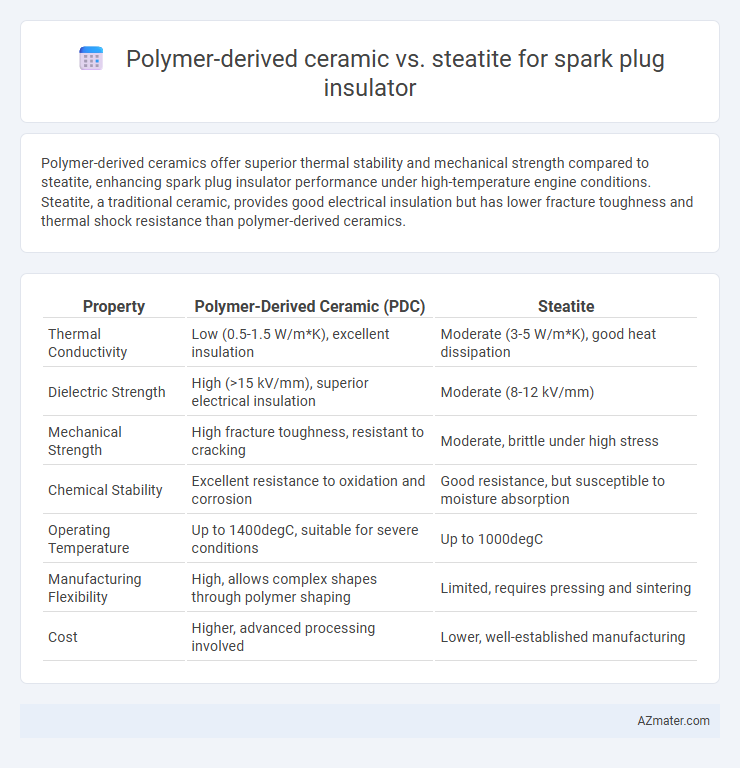Polymer-derived ceramics offer superior thermal stability and mechanical strength compared to steatite, enhancing spark plug insulator performance under high-temperature engine conditions. Steatite, a traditional ceramic, provides good electrical insulation but has lower fracture toughness and thermal shock resistance than polymer-derived ceramics.
Table of Comparison
| Property | Polymer-Derived Ceramic (PDC) | Steatite |
|---|---|---|
| Thermal Conductivity | Low (0.5-1.5 W/m*K), excellent insulation | Moderate (3-5 W/m*K), good heat dissipation |
| Dielectric Strength | High (>15 kV/mm), superior electrical insulation | Moderate (8-12 kV/mm) |
| Mechanical Strength | High fracture toughness, resistant to cracking | Moderate, brittle under high stress |
| Chemical Stability | Excellent resistance to oxidation and corrosion | Good resistance, but susceptible to moisture absorption |
| Operating Temperature | Up to 1400degC, suitable for severe conditions | Up to 1000degC |
| Manufacturing Flexibility | High, allows complex shapes through polymer shaping | Limited, requires pressing and sintering |
| Cost | Higher, advanced processing involved | Lower, well-established manufacturing |
Introduction to Spark Plug Insulator Materials
Spark plug insulators require materials with excellent thermal stability, electrical insulation, and mechanical strength to withstand harsh engine conditions. Polymer-derived ceramics (PDCs) offer superior high-temperature resistance and enhanced fracture toughness compared to traditional steatite, which has been widely used due to its cost-effectiveness and good dielectric properties. The shift toward PDCs in spark plug insulators is driven by their ability to maintain structural integrity and performance at elevated temperatures present in advanced combustion engines.
Overview of Polymer-Derived Ceramics
Polymer-derived ceramics (PDCs) are advanced materials synthesized from organosilicon polymers, offering superior thermal stability, high fracture toughness, and exceptional resistance to oxidation compared to traditional ceramics like steatite. These ceramics exhibit a fine microstructure with enhanced mechanical properties, enabling improved performance in spark plug insulators subjected to extreme thermal and electrical stresses. PDCs provide consistent dielectric strength and longevity, making them a promising alternative to steatite for high-performance spark plug applications.
Steatite: Traditional Ceramic Material
Steatite, a traditional ceramic material, has been widely used for spark plug insulators due to its excellent electrical insulation properties, high mechanical strength, and thermal stability up to 1200degC. Compared to polymer-derived ceramics, steatite offers consistent dielectric resistance and lower manufacturing costs, making it a durable and cost-effective choice in automotive ignition systems. Its natural composition, primarily magnesium silicate, ensures reliable performance under high voltage and temperature fluctuations typical in spark plug environments.
Material Properties Comparison: Strength and Hardness
Polymer-derived ceramics exhibit superior strength and hardness compared to steatite due to their dense, amorphous microstructure and excellent thermal stability, enhancing spark plug insulator durability. Steatite, a magnesium silicate ceramic, offers moderate hardness but lower mechanical strength, limiting its performance under high-stress, high-temperature conditions typical in ignition systems. The enhanced fracture toughness and thermal shock resistance of polymer-derived ceramics make them ideal for advanced spark plug insulators requiring robust mechanical integrity and resistance to wear.
Dielectric Performance and Electrical Insulation
Polymer-derived ceramics exhibit superior dielectric performance with high dielectric strength and low dielectric loss, making them ideal for spark plug insulators requiring reliable electrical insulation. Compared to steatite, polymer-derived ceramics offer enhanced thermal stability and higher breakdown voltage, resulting in improved insulation under extreme ignition conditions. Steatite, while cost-effective, typically presents lower dielectric strength and higher porosity, which may compromise the long-term electrical insulation reliability in high-performance spark plug applications.
Thermal Stability and Resistance
Polymer-derived ceramics exhibit superior thermal stability compared to steatite, maintaining structural integrity at temperatures exceeding 1400degC, essential for spark plug insulators exposed to extreme combustion environments. In contrast, steatite, a magnesium silicate ceramic, typically withstands temperatures up to 1100degC but offers higher mechanical toughness and machinability. The advanced thermal resistance of polymer-derived ceramics reduces thermal degradation and dielectric breakdown, enhancing spark plug lifespan and performance under rigorous engine conditions.
Manufacturing Processes and Scalability
Polymer-derived ceramics (PDCs) are produced through the pyrolysis of pre-ceramic polymers, enabling intricate shapes and fine microstructures with high thermal stability, whereas steatite insulators are manufactured by sintering natural magnesite clay, resulting in a more traditional, lower-cost ceramic with moderate thermal properties. The PDC process offers greater precision and potential for tailoring electrical and mechanical performance, but involves complex, time-consuming steps that limit large-scale manufacturing. Steatite's simpler, well-established sintering process supports mass production and scalability, making it more suitable for high-volume spark plug insulator applications despite lower performance compared to PDCs.
Cost-effectiveness and Economic Considerations
Polymer-derived ceramics offer superior thermal stability and mechanical strength compared to steatite, but their production costs are significantly higher, impacting overall cost-effectiveness in spark plug insulators. Steatite, commonly used due to its low raw material cost and ease of manufacturing, provides a more economically viable option for large-scale production despite lower performance metrics. Evaluating the trade-off between initial investment and long-term durability is crucial for optimizing the total cost of ownership in automotive spark plug applications.
Application Performance in Automotive Engines
Polymer-derived ceramics offer superior thermal shock resistance and dielectric strength compared to traditional steatite, enhancing spark plug insulator durability and reliability in high-performance automotive engines. Steatite, while cost-effective and electrically insulating, exhibits lower mechanical strength and thermal stability, limiting its application under extreme engine temperatures and pressures. The enhanced microstructure of polymer-derived ceramics results in improved insulation consistency and longer service life, making them ideal for advanced ignition systems in modern combustion engines.
Future Trends and Innovations in Spark Plug Insulators
Polymer-derived ceramic (PDC) insulators offer superior thermal stability, enhanced dielectric strength, and microstructural uniformity compared to traditional steatite materials, making them pivotal in advancing spark plug performance. Future trends emphasize integrating nanostructured PDC composites to achieve higher resistance to thermal shock and erosion, enabling longer service life and improved engine efficiency. Innovations also focus on eco-friendly manufacturing processes and additive manufacturing techniques for customized insulator geometries, addressing stringent emission regulations and evolving automotive demands.

Infographic: Polymer-derived ceramic vs Steatite for Spark plug insulator
 azmater.com
azmater.com